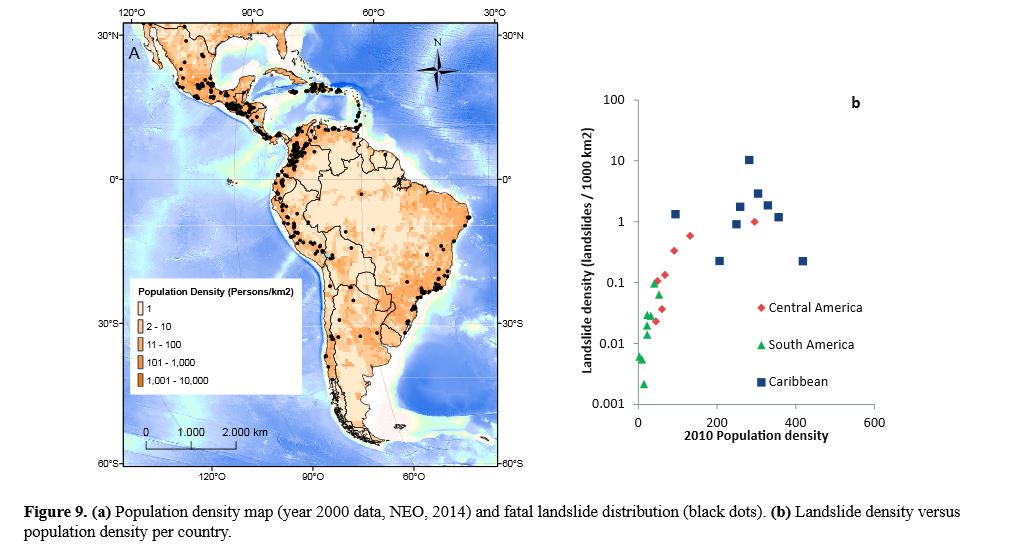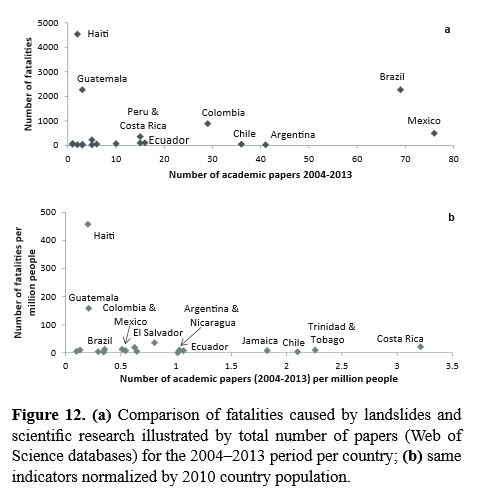21 September 2015
Human factors in landslide losses
Posted by Dave Petley
Human factors in landslide losses
One of the aspects of landslides that we looked at it my recent paper with my Chilean colleague Sergio Sepulveda (Sepulveda and Petley 2015 – open access version) was the role of population density in determining landslide losses in Latin America and the Caribbean. For reference I described the main focus of this paper in a blog post a month or so ago. For those countries in the study area we looked at the relationship between landslide density (i.e. the number of landslides that caused loss of life per 1000 square kilometres and the population density for the country in question (using data from 2010, which is in the middle of the study period). We found a pleasingly strong correlation:-

Human factors in landslide losses – Sepulveda and Petley (2015)
.
The graph is interesting for two reasons. First, it is clear that there is a strong correlation between landslide density and population density. Note that the landslide density is plotted on a log scale,suggesting that comparatively small increases in population density can lead to substantial increases in landslide density. The reasons for this are probably complex, but a key factor may be that there are simply more people in the landscape, meaning that any given landslide is more likely to cause a death. In addition, people themselves trigger landslides through slope cutting, deforestation and changes to the drainage network, amongst other things. It would be really interesting to examine this data in more detail to try to understand these factors properly – there is a great deal of anecdotal evidence about the role of human impacts on landslides, but few comprehensive, quantitative studies.
We also looked at the relationship between research and landslide losses, plotting the number of fatalities against the number of research papers on landslides over the study period:

Human factors in landslide losses – Sepulveda and Petley (2015)
.
The volume of landslide research in this part of the world, as measured in scientific publications, remains depressingly low given the magnitude of the costs that they inflict on society. Whilst the number of papers from Brazil and Mexico looks impressive, when this is normalised by total population the data look much less impressive. But note that by far the largest numbers of fatalities in this region occurred in Guatemala and Haiti, and by any metric the amount of research being undertaken there is far too low. There is a drastic need to start to undertake more detailed work in these locations if we are to reduce the burden that landslides place on society there. And as the El Nino builds, the consequences of our failure to manage landslides properly in Latin America is likely to become all too obvious.
Reference
Sepúlveda, S.A. and Petley, D.N. 2015. Regional trends and controlling factors of fatal landslides in Latin America and the Caribbean. Natural Hazards and Earth System Sciences, 15, 1821-1833, doi:10.5194/nhess-15-1821-2015. The full paper available to download as a PDF.


 Dave Petley is the Vice-Chancellor of the University of Hull in the United Kingdom. His blog provides commentary and analysis of landslide events occurring worldwide, including the landslides themselves, latest research, and conferences and meetings.
Dave Petley is the Vice-Chancellor of the University of Hull in the United Kingdom. His blog provides commentary and analysis of landslide events occurring worldwide, including the landslides themselves, latest research, and conferences and meetings.
Hi!
I’m a PhD student studying landslides and am interested in your work. I’m wondering if you and your colleague accounted for reporting bias at all in these analyses given that landslides are more likely to be reported where people live and when they result in fatalities.
Thanks for your time!
[This point is addressed in the original two papers. D]